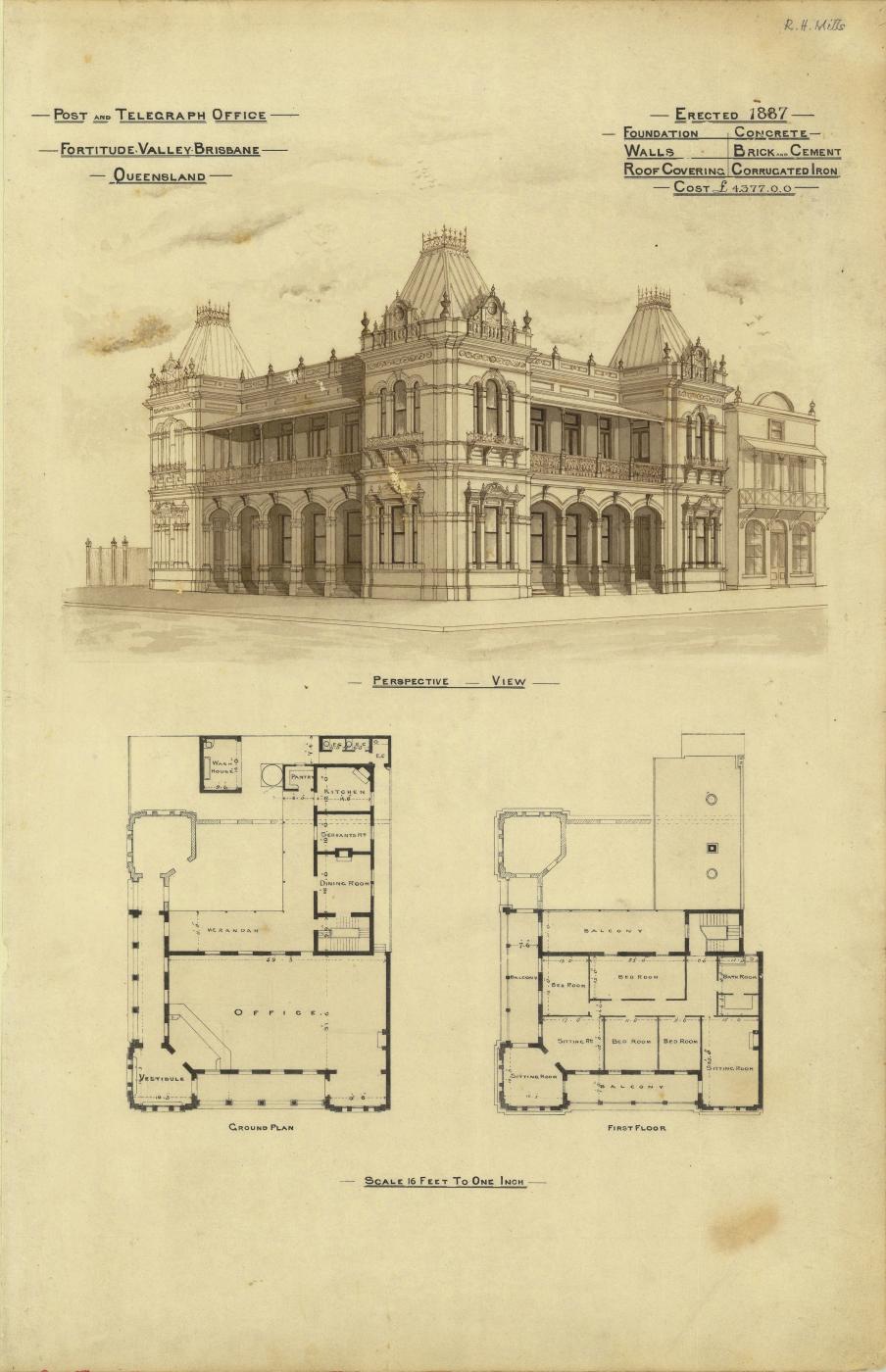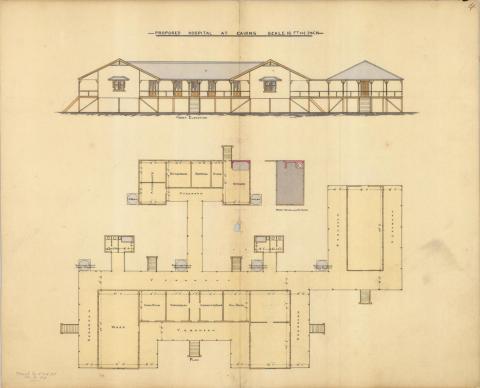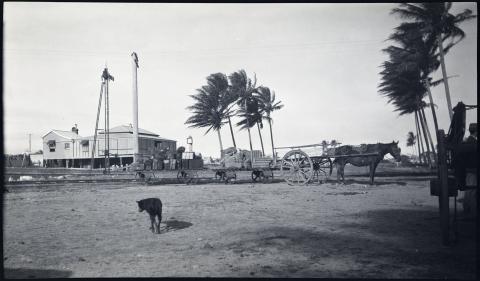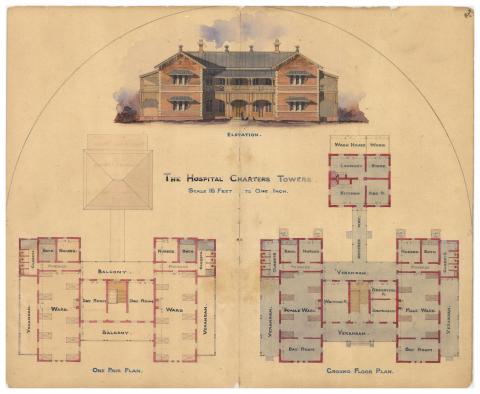
- News of the day
-
The Brisbane Courier, Wednesday 8 June 1887
The Valley Post Office
A complimentary supper tendered by residents of the Valley to the Postmaster-General (Hon. T. Macdonald-Paterson) and the Minister for Works (Hon. W. Miles). was held in the new Post Office, Ann-street, last evening. [...] The large room in which the room was provided by Mr. Slawson, of Wickham-street, was gaily decorated with flags, and the tables were lavishly adorned with foliage plants from the nursery of Mr. Matthew of New Farm.
Alderman Heal in introducing the toast of the evening, said their meeting was a convivial one, and not political [...] and he congratulated the Ministry on not having overlooked the growing capacity of the Valley, as they had provided an office which would not only answer present purposes, but be sufficient for their requirement for many years to come.
[...] Alderman Heal had said that this was the first public building erected in the Valley - (hear, hear) - at any rate if it was so it was evidently not there before it was wanted (Cheers). [...] In regards to the railway question, he agreed that it was a local topic and not politics. Still it was a thing of the past and he hoped it would not be long before the Valley people had an apportunity of celebrating the opening of the Central Valley railway station (Loud cheering).
- Background
-
The Fortitude Valley Post Office and Telegraph Office as it was first called, was constructed in 1887 by William Ferguson for the Queensland Post and Telegraph Department to a design prepared by the Colonial Architect's Office of the Department of Public Works. The original working drawings are unsigned however it is believed that the design was carried out by either JJ Clarke, who was the Colonial Architect from 1883 to 1886 or George Connolly, who held the position from 1887 to 1891. The building, composed in the Victorian Italianate architectural style, is one of only ten substantial Queensland post offices designed in this style that were all built between 1879 and 1898. Comparatively, the Fortitude Valley Post Office has the most ornately detailed cement rendered facade and is the only post office designed and constructed with mansard roofs. The building was also one of only two masonry post offices that were built in 1887 - all others were constructed of timber.
Government policies in 1887 required that post and telegraph services were combined, and that accommodation for Postmasters and their families be provided. Accordingly the Fortitude Valley Post Office was designed to have post and telegraph services at ground level with living quarters above. A single storey service wing originally extended northwards to the rear of the building and opened onto a fenced courtyard abutting Ballow Street. Internally the ground floor consisted of a spacious office area for the combined services of post and telegraph. Access to the postal services was via the vestibule located at the corner of Ann and Ballow Streets that led to a small public area with a diagonal counter. Telegraph or parcel services were accessed via the smaller vestibule located at the far end of the arcade facing Ann Street. The first floor was occupied entirely by the Postmaster's living quarters and consisted of two living rooms, four bedrooms and an internal bathroom. The single storeyed service wing at the rear contained of the Postmaster's dining room, kitchen and servant's room. Earth closets were located adjacent to the kitchen, in northern corner of the site.
At the time of the Fortitude Valley Post Office's construction, the suburb was experiencing a period of great business and residential expansion. Nearby areas such as New Farm and Teneriffe to the east and Breakfast Creek and Bulimba Reach to the north were similarly experiencing expansion. The opening of the Teneriffe wharves to international shipping accelerated the growth of the area and this, together with a large increase in the volume of business, placed severe strain on the original postal and telegraph facilities in Fortitude Valley that had been set up in 1877. The government's purchase of the site at the corner of Ann and Ballow Streets in 1884 caused a controversy amongst the local residents and businesses in Fortitude Valley who desirous of a centrally located post office closer to the centre of business, at the corner of Brunswick and Wickham Streets. The matter caused some debate within the Post and Telegraph Department in 1885, however plans for the Ann Street site proceeded irrespectively. Aversion to the post office's location persisted among the local community for many years until eventually the matter was settled in 1936 by the Director-General of the Postmaster-General's Department in Melbourne who declared that funds for the construction of a new post office would not be available.
Following the formation of the Postmaster General's Department in 1901, the responsibility for the Fortitude Valley Post Office was transferred to the Commonwealth. Minor alterations were made to the ground floor interior in 1909 and again in 1925. It was around this time that the post office took on the ancillary responsibility of social security payments. A report prepared by the Acting District Inspector in November 1929 stated that 1 205 pensions were being paid weekly from the Fortitude Valley Post Office and it was understood that this was, with one exception, the heaviest pensions paying centre in the Commonwealth at the time.
Documentation of the removal of the mansard roofs and cast concrete capitals from the Fortitude Valley Post Office have not be found however it is believed to have occurred prior to 1949. Pressure from the Commonwealth to expand facilities eventually led to the vacation of the Postmaster from the first floor c.1950. It was proposed that the rooms be used for a Telegraph and Despatch room and staff facilities, however the area was used minimally thereafter. In 1958 major alterations were carried out on the entire building. Amongst these changes was the introduction of a stairwell in the main entrance vestibule, private letter boxes in the smaller vestibule off Ann Street, removal of all interior walls on the first floor and the partial rebuilding of the service wing at the rear. Further alterations, carried in 1970, caused the rear wing to be completely demolished and replaced with a larger two storey wing that abuts Ballow Street. Substantial reorganisation of the original post office's interior was also carried out at this time. Suspended ceilings were introduced in some areas of the ground floor at this time.
The Postmaster General's Department remained responsible for the Fortitude Valley Post Office until 1975 when Australia Post and Telecom Australia were created, thus dividing the postal and telecommunication services into two semi-government departments. Australia Post carried out alterations to the building in 1987, which effectively stripped the ground floor interior of all previous accretions. Externally, some restoration of the original fabric was carried out and a historic colour scheme was reinstated.
Courtesy of the Queensland Heritage Register



